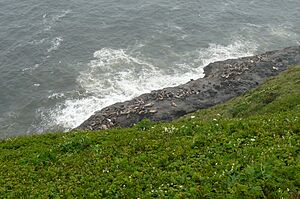Sea Lion Caves facts for kids
Quick facts for kids Sea Lion Caves |
|
|---|---|

Sea lions inside the caves
|
|
| Location | Florence, Oregon |
| Geology | Littoral |
| Entrances | 3 |
| Difficulty | novice |
| Access | private, with admission |
Sea Lion Caves are a cool system of connected sea caves in Oregon, USA. They are open to the big Pacific Ocean. You can find them about 11 miles (18 km) north of Florence, Oregon. This spot is about halfway along the 400-mile (644 km) Oregon Coast. The caves are right below U.S. Highway 101, which runs high above the ocean. To get inside, you enter through a gift shop building.
Contents
Exploring the Sea Lion Caves
The main part of the caves is right at sea level. The ocean waves are always washing into this huge room. This main cavern is about 2 acres (0.81 ha) big. Its rocky ceiling is super high, reaching about 125 feet (38 m) up!
Different Cave Entrances
From the main room, a low path stretches about 1,000 feet (305 m) south. This path leads to another opening to the sea. When the tide is high, this path fills with water. But at low tide, it's dry.
There's also a western entrance. This is a short, tall passage where ocean water flows in all the time. A third entrance is about 50 feet (15 m) above the ocean. This spot is a great observation area. From here, you can see the whole cave system and all the amazing wildlife inside.
Colors and Shapes Inside
The walls of the caves are covered in beautiful natural colors. You'll see greens, pinks, purples, and reds. These colors come from lichens, algae, and minerals. Some of the rough rock shapes even look like famous faces. People have named them things like Lincoln's Head and The Goddess of Liberty.
Amazing Animals of the Caves
Sea Lion Caves is a special place for animals. It's the only known mainland spot where Steller sea lions live and raise their young. These caves are also a winter home for some California sea lions.
Birds Living Here
Many different kinds of birds also call Sea Lion Caves home. You might see pigeon guillemots and Brandt's cormorants. Different types of gulls fly around, too. Look out for tufted puffins and sometimes even a hawk or a bald eagle.
Whale Watching Spot
Below the gift shop, there's a special deck for watching whales. This deck is about 300 feet (91 m) above the ocean. From here, you can see about 20 miles (32 km) out to sea. It's a very popular place to spot whales!
You might see orcas (killer whales) migrating past the caves once a year. Gray whales are seen much more often. Sometimes, small groups of gray whales even stop their journey right near the shore to feed.
History of Sea Lion Caves
Discovery and Early Ownership
A local sailor named Captain William Cox discovered Sea Lion Caves in 1880. He sailed into the western entrance on a calm day. The story says he got stuck in the caves for several days during a storm! He reportedly ate sea lion meat to survive.
Captain Cox bought the land in 1887 from the State of Oregon. His family owned the property until 1926. Back then, there were no roads nearby. The rocky hillsides were used for sheep to graze.
Opening to the Public
In 1927, R. E. Clanton bought the land. He wanted to open the caves as a business. In 1930, it looked like U.S. Highway 101 would be built right past the caves. So, Clanton teamed up with J. G. Houghton and J. E. Jacobson.
These three partners decided to build a safe way for people to reach the caves. They dug a 1,500-foot (457 m) long trail by hand into the cliff. At the bottom, they built a wooden tower with 135 steps. This tower went down to the north entrance of the caves. Even though it was hard and dangerous work, the trail and stairs made it safe for visitors. Sea Lion Caves opened to the public in August 1932.
Growth and Improvements
At first, not many people visited. The highway was still gravel until 1934. Also, there were five ferry crossings within 100 miles (161 km) that people had to take to use the highway. But word spread, and more people started coming. However, visits stopped almost completely during World War II.
In 1934, R. A. Saubert became a part owner. The Clanton, Saubert, and Jacobson families ran the caves until 2006. Then, the Saubert and Jacobson families took over the partnership.
A big change happened in 1961 when an elevator was added. This made it much easier for visitors to get down to the caves. The elevator took three years to build. It can carry 23 people at a time and travels 208 feet (63 m) down in about 2.8 miles per hour (4.5 km/h). It can move 400 people every hour! In 2019, the old elevator was replaced with a new one. This was because parts for the old one were hard to find and had to be made by hand.


